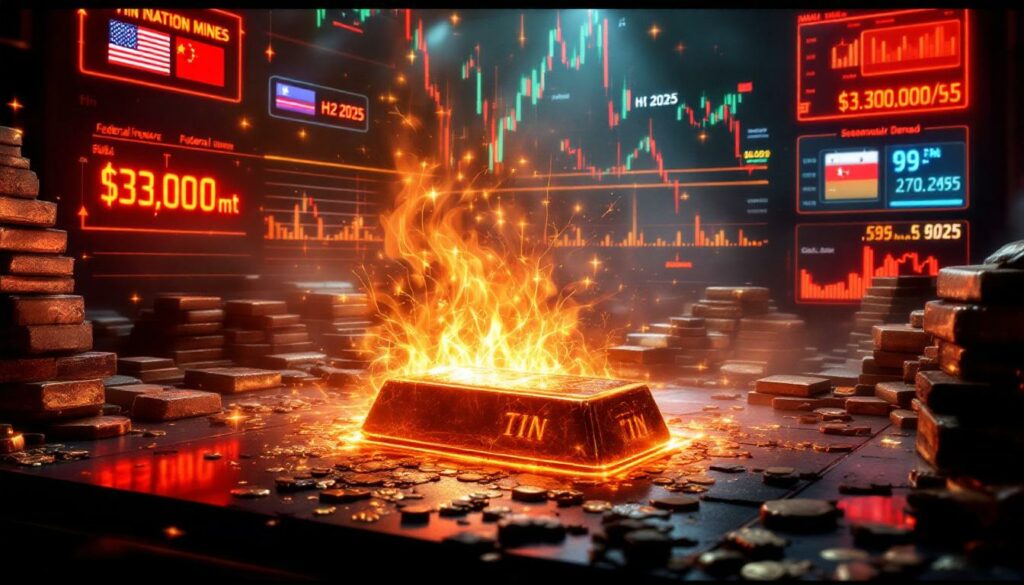Why Is SHFE Tin Trading Under Pressure?
The tin market is experiencing notable downward pressure as a complex interplay of supply chain disruptions, seasonal demand weakness, and macroeconomic factors converge. Recent trading data reveals significant bearish momentum that has investors and analysts closely monitoring key technical thresholds.
Current Market Performance Indicators
SHFE tin contract 2508 closed at 261,740 yuan/mt in midday trading on July 17, 2025, marking a 0.66% decline from the previous session. The contract exhibited a relatively narrow trading range of 260,640–262,800 yuan/mt, accompanied by declining open interest—a concerning signal that typically indicates trader hesitation and diminishing market participation.
Meanwhile, the global benchmark LME 3-month tin price registered at $32,875/mt, down 0.35%. More worryingly, LME tin reached a new July low of $32,799/mt during Asian trading hours, representing a 1.48% drop and signaling the potential for further downside momentum.
Market technicians highlight two critical price levels currently driving trader sentiment:
- Resistance level: The 60-day moving average at 263,000 yuan/mt has formed a formidable ceiling for SHFE tin
- Support breach: LME tin's fall below the psychologically important $33,000/mt threshold has opened the door to deeper corrections
As noted by Shanghai Metal Market (SMM) analysts, "Supply chain disruptions have been unable to offset the suppression from off-season demand," creating a fundamental imbalance that continues to pressure prices despite logistical challenges that would typically support values.
Technical Analysis of Price Movements
The daily chart pattern reveals persistent resistance around the 263,000 yuan/mt level, where the 60-day moving average has consistently rejected upward price movements. This technical barrier has proven difficult to overcome amid the current market environment characterized by what SMM describes as a "weak expectations versus weak reality dynamic."
With LME tin having decisively broken below $33,000/mt, technical analysts now project potential testing of the $31,000-32,000/mt support range if bearish momentum continues. This breakdown of key support reflects deteriorating market sentiment and could invite further selling pressure.
Two key technical indicators warrant particular attention:
- Declining open interest: This metric suggests traders are increasingly hesitant to maintain or establish new positions, reflecting uncertainty about near-term price direction
- Sluggish turnover: Reduced transaction volumes indicate diminished market participation across both speculative and commercial segments
These technical signals, combined with the fundamental headwinds discussed below, paint a challenging picture for tin prices in the immediate term.
How Are Macroeconomic Factors Affecting Tin Markets?
Global economic policies, particularly monetary decisions and trade tensions, are creating significant headwinds for industrial metals including tin. These macroeconomic factors are amplifying fundamental pressures within the tin market itself.
Federal Reserve Policy Uncertainty
The June U.S. Consumer Price Index (CPI) registered a 2.7% year-over-year increase, exceeding the Federal Reserve's 2% target and complicating the monetary policy outlook. This inflation reading has materially reduced market expectations for interest rate cuts, with the probability of a September rate reduction falling to 62%—down from more optimistic forecasts earlier in the year.
Key Federal Reserve officials have provided mixed signals that have amplified market uncertainty:
- Atlanta Fed President Bostic stated that "inflation is at a turning point," suggesting potential policy easing
- Meanwhile, Federal Reserve Bank official Logan emphasized the "need to maintain tight policies," indicating reluctance to cut rates prematurely
"The contradictory signals from Fed officials are creating a policy uncertainty premium that weighs particularly heavily on industrial commodities like tin, which are sensitive to interest rate expectations," notes SMM's analysis.
Political tensions have further complicated monetary policy expectations, with former President Trump criticizing Fed Chair Powell's "failure to cut interest rates" while denying rumors about intentions to replace Powell. This political dimension adds another layer of uncertainty to an already complex monetary policy landscape.
Global Trade Tensions Impact
Trade policy developments have emerged as a significant negative catalyst for industrial metals markets. The United States is implementing substantial new tariffs impact markets that threaten to disrupt global trade flows:
- 30% tariffs targeting European Union and Mexican imports (effective August 2025)
- 40% punitive tariffs specifically aimed at Vietnamese transshipments of Chinese goods
These trade barriers are creating ripple effects throughout global supply chains and dampening industrial demand forecasts. Simultaneously, the U.S. dollar index has strengthened to 99, creating additional headwinds for dollar-denominated commodities like tin.
The combination of trade tensions and dollar strength has created what SMM describes as "macro risk-off sentiment," limiting price rebound potential across the industrial metals complex. These external pressures are amplifying tin's fundamental challenges, creating a particularly challenging price environment.
What's Creating the Supply-Demand Imbalance in Tin Markets?
The current tin market is characterized by a growing supply-demand imbalance that stems from both production developments and seasonal consumption patterns. This mismatch between supply and demand fundamentals is a primary driver of recent price weakness.
Supply Chain Disruptions Analysis
Market analysts anticipate a significant shift in the supply landscape during the second half of 2025, with Myanmar production resumption expected to inject incremental supply into global markets. This development represents a crucial inflection point for tin's supply dynamics after previous constraints.
Despite ongoing logistics challenges in certain production regions, these supply chain bottlenecks have proven unable to provide meaningful price support. As SMM reports, "Supply chain disruptions have been unable to offset the suppression from off-season demand," highlighting how fundamental demand weakness is overwhelming what would typically be supportive supply constraints.
The geographical redistribution of production—particularly Myanmar's expected output increases—is reshaping the market balance in ways that favor supply growth over consumption expansion. This dynamic creates persistent downward pressure on prices despite isolated logistical challenges that might otherwise support values.
Seasonal Demand Patterns
Current market conditions reflect the classic "off-season" demand weakness that typically characterizes mid-year tin consumption. The electronics manufacturing sector, a primary tin consumer for solder applications, often experiences slower activity during this period before ramping up for year-end production.
This seasonal pattern has created what SMM analysts describe as a "weak expectations versus weak reality dynamic" where even pessimistic forecasts are being confirmed by disappointing actual consumption. Current demand levels have proven insufficient to absorb existing supply, let alone the anticipated production increases from Myanmar and other sources.
The tin market's seasonal consumption cycles create predictable pressure points that traders have increasingly factored into positioning decisions. With current conditions aligning with these seasonal patterns, the market faces limited catalysts for demand-driven price support in the near term.
How Might Tin Prices Evolve in Coming Months?
The trajectory of tin prices over the coming months will depend on the interplay between technical market factors, fundamental developments, and broader macroeconomic conditions. Several key considerations will shape price evolution in the near to medium term.
Short-Term Price Outlook Factors
Technical analysis suggests continued challenges for tin prices, with critical support levels now under threat. Market observers should closely monitor:
- LME tin support range: The $31,000-32,000/mt zone represents the next significant technical floor after breaking below $33,000/mt
- SHFE resistance: The 60-day moving average at 263,000 yuan/mt continues to cap upward movements
- Relative strength indicators: Currently suggesting oversold conditions in some timeframes, potentially limiting further immediate downside
Potential price catalysts that could alter this bearish trajectory include unexpected supply disruptions (particularly from major producers) or an earlier-than-anticipated seasonal demand recovery. However, SMM notes that "macro risk-off sentiment and escalating trade tensions limit price rebound potential" even if such positive catalysts emerge.
The price outlook must also account for the anticipated supply increases from Myanmar in H2 2025, which could exert additional downward pressure unless matched by consumption growth. Furthermore, iron ore trends and other base metal price forecast models suggest continued volatility across the commodities spectrum.
Market Sentiment Indicators
Current market sentiment metrics reflect pervasive caution among market participants:
- Declining open interest on SHFE tin contracts indicates traders are reducing exposure and limiting new position establishment
- Reduced trading volumes suggest limited conviction in either direction, with participants adopting a wait-and-see approach
- Institutional positioning appears increasingly defensive, with risk reduction strategies predominating
The balance between speculative and commercial traders has shifted toward greater commercial hedger dominance, typically a sign of market participants protecting against downside risks rather than positioning for price appreciation.
"The current sentiment indicators reflect a market in defensive positioning mode, with participants more focused on risk management than opportunity capture," according to SMM's analysis.
This cautious positioning could amplify price movements in either direction once clearer fundamental signals emerge, potentially creating volatility even amid the current bearish trend.
What Are the Key Risk Factors for Tin Markets?
The tin market faces a complex risk landscape that combines geopolitical uncertainties, economic challenges, and industry-specific concerns. Understanding these risk factors is essential for market participants navigating the current environment.
Geopolitical Risk Assessment
Trade policy developments represent the most immediate geopolitical risk to tin markets, with significant implications for both supply and demand:
- The implementation of 30% U.S. tariffs on EU and Mexican imports (effective August 2025) threatens to disrupt established trade flows
- 40% punitive tariffs targeting Vietnamese transshipments of Chinese goods could reshape regional supply chains
- These trade barriers risk fragmenting global metal markets and creating inefficient redirections of material flow
Beyond tariffs, potential regulatory changes affecting mining operations in key producing regions could create supply-side uncertainty. Environmental regulations, labor policies, and resource nationalism trends all represent ongoing risks to production stability.
Cross-border shipment constraints—whether from regulatory changes, transportation bottlenecks, or geopolitical tensions—introduce additional variables that could either restrict supply (price positive) or demand (price negative) depending on where and how they manifest.
Economic Uncertainty Considerations
The trajectory of interest rates remains a central economic risk factor for tin and other industrial metals. The reduced probability of September rate cuts (now 62%) and conflicting Federal Reserve signals create an uncertain monetary policy environment that typically weighs on commodity performance.
Currency volatility, particularly the strengthening U.S. dollar (index at 99), creates headwinds for dollar-denominated commodities like tin. Further dollar appreciation would add additional pressure to tin prices independent of fundamental factors. Moreover, US tariffs and inflation concerns continue to influence market sentiment across industrial commodities.
Manufacturing sector health serves as a critical demand driver for tin, with particular sensitivity to:
- Electronics industry trends: Solder demand for consumer electronics, data centers, and telecommunications
- Construction sector activity: Tin use in various building applications
- Automotive production: Requirements for both traditional and electric vehicle manufacturing
Economic slowdowns in any of these sectors would compound the current seasonal demand weakness, potentially extending price pressure beyond typical cyclical patterns. Additionally, investors seeking safer havens may explore metal investment strategies to diversify away from industrial metals during uncertain economic periods.
FAQ: Tin Market Fundamentals
What is causing the current pressure on SHFE tin prices?
The current pressure on SHFE tin prices stems from a multi-faceted combination of factors. Primary among these is the anticipated supply increase from Myanmar in H2 2025, which is expected to inject incremental material into a market already experiencing seasonal demand weakness. This fundamental imbalance is being amplified by macroeconomic headwinds, including a strengthening U.S. dollar (index at 99) and escalating global trade tensions, notably the new 30% U.S. tariffs targeting EU and Mexican imports and 40% tariffs on Vietnamese transshipments of Chinese goods.
As SMM analysts note, "Supply chain disruptions have been unable to offset the suppression from off-season demand," creating a situation where even typical supply-side support factors cannot overcome the broader market pressures.
How do supply chain disruptions affect tin pricing?
While supply chain disruptions typically support prices through reduced material availability, the current market environment demonstrates the limitations of this dynamic. Present disruptions are being overshadowed by weak seasonal demand and expectations of increased production from Myanmar, preventing logistical challenges from providing meaningful price support.
The market is experiencing what SMM describes as a "weak expectations versus weak reality dynamic," where even pessimistic demand forecasts are being confirmed by disappointing actual consumption. This fundamental weakness overwhelms the typically supportive effects of supply chain constraints, illustrating how demand factors can dominate price formation even amid logistical challenges.
What technical levels should tin traders monitor?
Tin traders should focus on several critical technical levels that could determine near-term price direction:
- SHFE tin resistance: The 60-day moving average at 263,000 yuan/mt has formed a persistent ceiling that limits upward price movement
- LME tin support: Having already breached the significant $33,000/mt level, attention now turns to the $31,000-32,000/mt support range that could determine whether a deeper correction unfolds
Technical analysts also note the importance of monitoring trading volumes and open interest for confirmation of price movements. Currently, declining open interest suggests trader hesitation, while sluggish turnover indicates reduced market participation—both potentially bearish signals in the current context.
How might US monetary policy affect tin markets in 2025?
U.S. monetary policy creates both direct and indirect effects on tin markets. With June inflation at 2.7% year-over-year and Federal Reserve officials sending mixed signals about rate cut timing, monetary policy uncertainty has reduced the probability of September rate cuts to 62%, down from more optimistic earlier forecasts.
This policy uncertainty typically strengthens the U.S. dollar (currently at index 99), creating headwinds for dollar-denominated commodities including tin. Beyond currency effects, interest rate decisions impact broader industrial activity and financing costs throughout the metals supply chain, from mining operations to end-user manufacturing.
As the Federal Reserve navigates conflicting priorities of inflation control and economic growth support, tin markets will remain sensitive to both official statements and policy implementation throughout 2025.
What is the relationship between tin and other industrial metals?
Tin shares broader industrial metal market sentiment but can diverge based on its specific supply-demand fundamentals. Currently, trade tensions are suppressing demand expectations across the industrial metals complex, creating correlated downward pressure.
However, tin's unique applications in electronics soldering (roughly 50% of consumption) give it different demand drivers than metals like copper or aluminum, which are more directly tied to construction and general industrial activity. This specialised demand profile can create periods where tin prices diverge from broader base metal trends, particularly during technology sector boom-bust cycles.
Supply-side factors also differentiate tin, with its relatively concentrated production geography making it more vulnerable to disruptions in specific regions like Myanmar, Indonesia, or Peru compared to more geographically diversified metals.
Want to Profit from the Next Major Mineral Discovery?
Discovery Alert's proprietary Discovery IQ model provides real-time notifications when significant mineral discoveries are announced on the ASX, helping you capitalise on potentially transformative opportunities before the broader market. Visit our discoveries page to see how past mineral discoveries have generated substantial returns for early investors.




